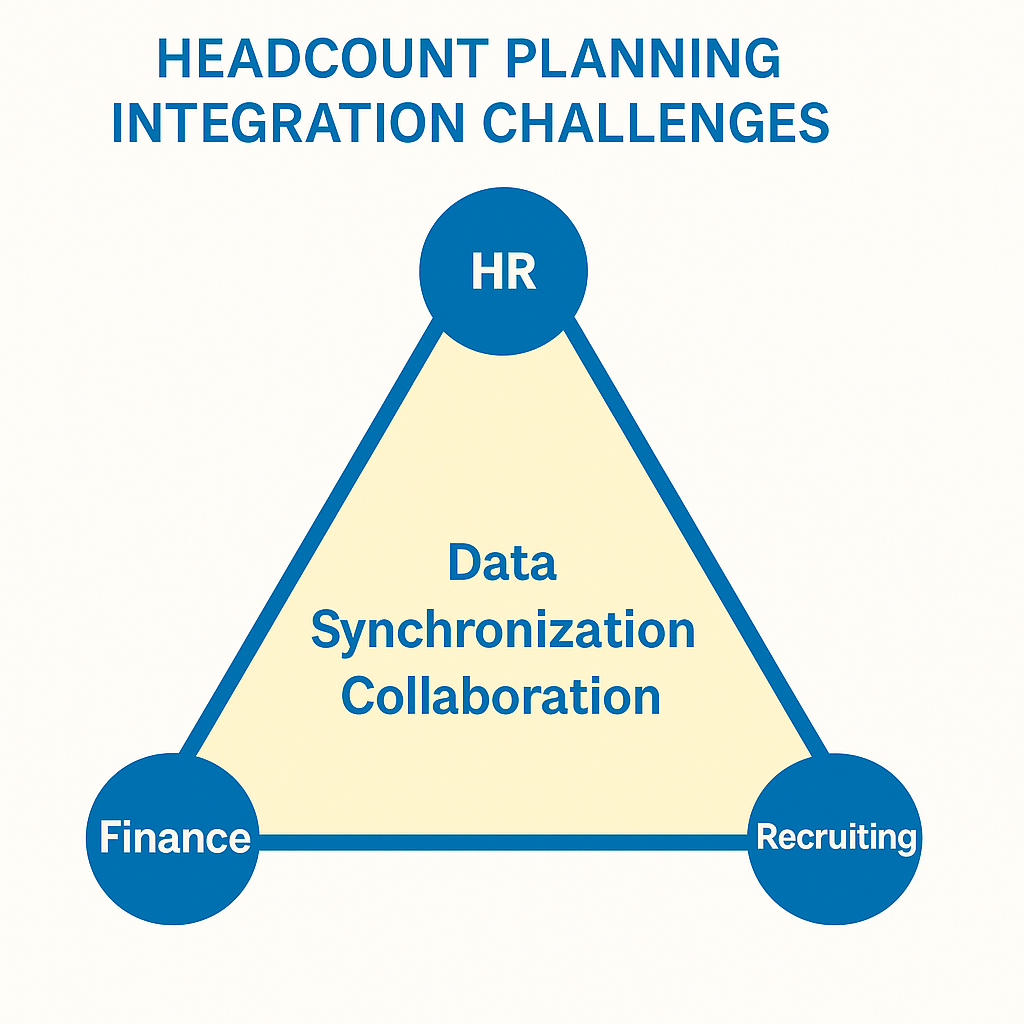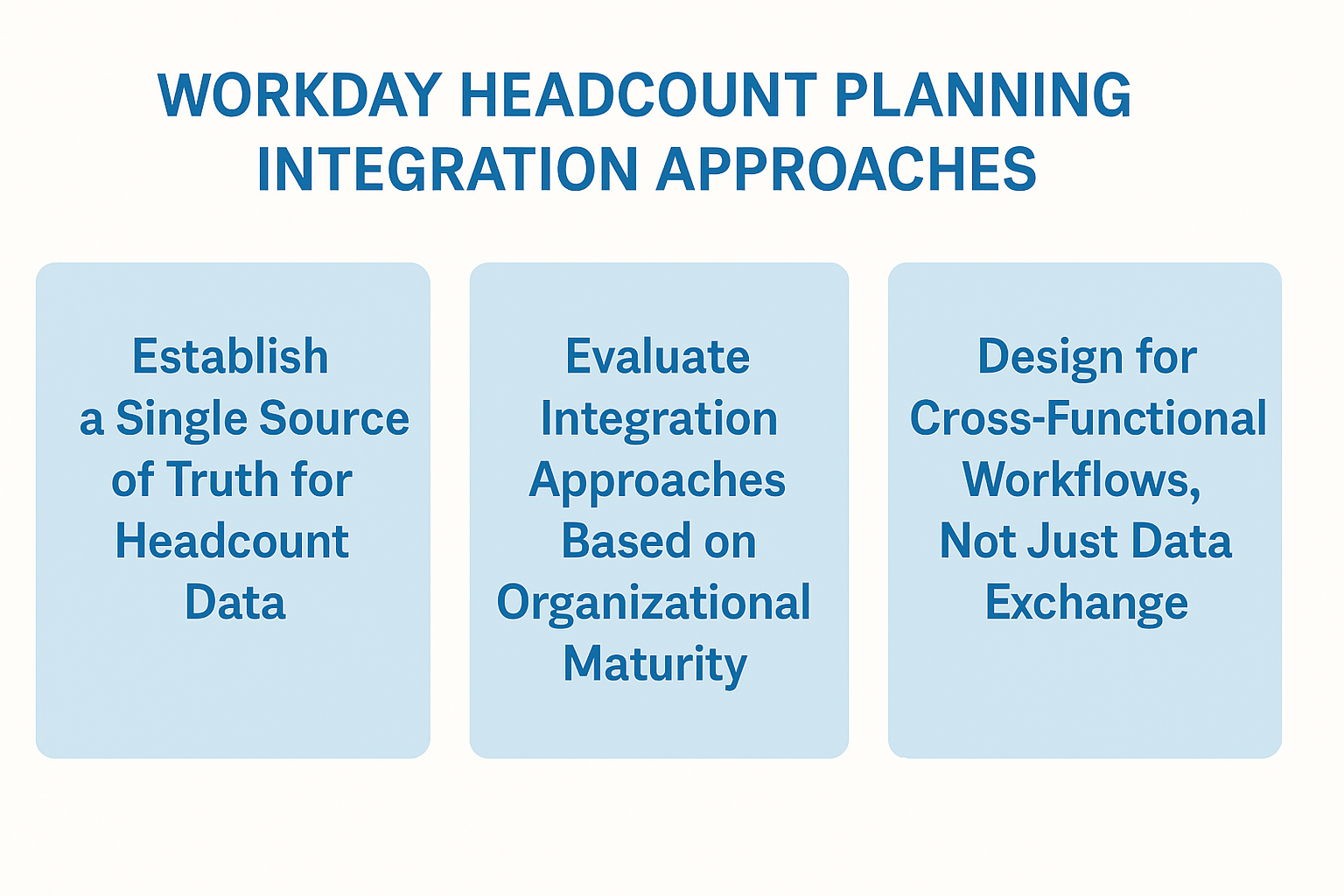Your Guide to Workday Integration With Your ATS for Seamless Headcount Management
Headcount data can deteriorate in as little as 48 hours when your systems aren't properly integrated. This rapid decay creates a ripple effect across your entire organization.
Imagine your headcount management process as a complex ecosystem where Finance, HR, and Recruiting must work in perfect harmony. Yet each team lives in their own specialized environment:
Finance in planning systems (e.g. Adaptive Planning, Anaplan, etc)
HR in Workday
Recruiting in an applicant tracking system (ATS) (e.g. Greenhouse, Ashby, SmartRecruiters, iCims, etc)
Without proper integration, these teams quickly fall out of sync, creating a cascade of problems that impact your entire organization.
Having implemented headcount planning software for dozens of organizations over the past 13 years, we've witnessed the consistent challenges that arise when these critical systems don't communicate effectively. Recruiting teams waste time chasing outdated headcount approvals, Finance makes decisions using last quarter's data, and HR teams exhaust themselves trying to maintain data integrity across disconnected platforms.
Successful headcount management integration isn't merely about technical connections—it's about creating a unified strategy that addresses fundamental questions: How does headcount flow from budgeting to HR systems? Who controls data at each stage? When and how does information transition between systems? The answers to these questions form the foundation of effective headcount management.
For customers using a third-party ATS, Workday integration is essential—but the approach you take determines whether that Workday integration becomes a competitive advantage or an administrative burden. Drawing from our extensive experience with organizations ranging from high-growth startups to global enterprises, we'll explore how to transform your headcount planning process through strategic Workday integration.
The Three-Dimensional Challenge of Headcount Planning Integration
Connecting your headcount planning ecosystem presents challenges that extend far beyond technical implementation. Understanding these challenges is the first step toward creating an effective solution.
The Data Synchronization Dilemma
At the heart of headcount planning is a complex web of interconnected data that must remain synchronized across multiple systems:
Master Data Fragmentation: When your Workday foundational data, organizational hierarchies, job profiles, and compensation data aren't consistently reflected in applicant tracking and financial planning systems, your entire headcount planning process becomes unstable. Maintaining this foundation is particularly challenging when there is a high volume of organizational changes or internal mobility.
Requisition Management: The journey from headcount approval to filled position involves multiple handoffs between systems. Finance approves the budget, Recruiting kicks off and manages requisitions from the ATS to Workday, and HR Operations transitions in during onboarding once a candidate is hired. Without seamless Workday integration, critical information gets lost during these transitions, creating bottlenecks and errors.
Financial Visibility Gaps: Effective headcount management requires real-time financial context. When a recruiter is evaluating compensation for a potential hire, they need approval from HR to uplevel a role and they need to be consulted by Finance to ensure the budget is approved. Similarly, when Finance is forecasting headcount costs, they need realistic hiring timelines from Recruiting to ensure their attributing costs accurately. These connections are often the weakest links in the integration chain.
The Cross-Functional Coordination Challenge
The technical challenges of integration are matched by equally significant organizational hurdles. Most organizations attempt to coordinate headcount planning through manually updated spreadsheets or fragmented dashboard solutions.
These approaches invariably lead to data discrepancies and decision delays as information ages rapidly once exported from source systems. This coordination breakdown creates three persistent problems:
Misaligned Recruiting Efforts: Recruiting teams waste valuable resources pursuing roles that are no longer priorities or working with outdated compensation parameters.
Inaccurate Financial Forecasting: Finance teams build budgets on flawed assumptions about hiring timelines and compensation trends.
Reactive HR Decision-Making: HR teams spend their time fighting data fires instead of focusing on strategic workforce planning.
Consider this real-world scenario: A technology company received approval to expand its engineering team by 25 positions. Three months and thousands of recruiting hours later, market conditions forced a hiring freeze. Because their systems weren't integrated, Recruiting had no visibility into changing financial projections, Finance couldn't see the pipeline of candidates in late stages, and HR was caught in the middle, trying to reconcile conflicting priorities.
The result? Significantly wasted effort, hundreds of thousands of dollars in sunk costs, and damaged credibility with candidates.
Without integrated systems and processes, headcount planning becomes a constant exercise in reconciliation rather than strategic workforce development.
How to Build an Integrated Headcount Planning Foundation
Creating a successful Workday integration for headcount planning requires a holistic approach that addresses people, processes, and technology simultaneously. Here's how to build a foundation that supports your entire workforce planning ecosystem.
Align Stakeholder Needs and Responsibilities
Different departments have distinct—sometimes competing—needs from your headcount planning system. Understanding and addressing these varied requirements is essential for adoption and effectiveness.
Finance Requirements:
When Finance has proper Workday integration, they can make proactive decisions about resource allocation instead of discovering budget issues after it's too late to course-correct. They require:
Accurate real-time visibility into current and projected headcount costs
Ability to adjust budgets and see immediate impacts on hiring plans
Scenario modeling capabilities for workforce planning
Variance reporting between planned and actual headcount expenses
HR Requirements:
With proper headcount planning integration, HR transforms from data janitors to strategic workforce advisors. That means they can use their time to optimize talent strategies rather than reconciling inconsistent information. To do so, they need:
Centralized control over organizational structure and job architecture
Streamlined workflows for position management and position control
Automated compliance tracking for headcount-related regulations
Comprehensive data governance to maintain system integrity
Recruiting Requirements:
When Recruiting works in a properly integrated environment, they can focus their efforts on the highest-priority roles and provide accurate hiring timeline projections to the rest of the organization. Here’s what they need to do it:
Real-time visibility into approved headcount status
Automated requisition creation based on approved headcount
Current compensation guidelines synchronized from HR and Finance
Pipeline reporting that connects to financial forecasts
A global technology company we worked with illustrates the impact of stakeholder alignment. Previously, their quarterly headcount planning process involved two weeks of manual data collection and reconciliation, followed by contentious meetings where each department defended its numbers.
After implementing an integrated approach with clear data ownership, their planning cycle shortened to three days and enabled real-time reconciliation throughout the process. More importantly, the conversations shifted from debating whose numbers were correct to strategic discussions about workforce optimization.
The fundamental principle is simple: When each stakeholder has their specific needs addressed through the headcount management process, they become advocates rather than obstacles.
Pay Attention to Critical Data Elements for Effective Headcount Planning
Not all headcount data is created equal. Certain elements are absolutely essential for successful headcount planning integration and should receive priority attention:
Strategic Headcount Data
Your foundational headcount planning data establishes the parameters for all workforce decisions. This includes:
Annual and quarterly headcount budgets by department
Strategic hiring priorities and timelines
Approved compensation ranges for each role
Organizational design and reporting relationships
This data typically originates in strategic planning sessions and financial systems before flowing into Workday and the ATS.
Operational Headcount Data
This middle layer connects strategic plans to day-to-day execution and includes:
Position Management and open positions
Open requisition status and aging
Pipeline metrics by department and role
Time-to-fill projections
Backfill requirements from attrition
This data often moves bidirectionally between systems, being updated by various stakeholders throughout the headcount lifecycle.
Analytical Headcount Data:
This layer provides the insights needed for continuous improvement:
Historical hiring performance metrics
Budget variance analysis
Headcount forecasting accuracy
Recruiting efficiency metrics
Onboarding efficiency metrics
The most successful organizations establish clear data governance policies that define ownership, update frequency, and validation requirements for each of these data categories. Without this structure, even the most sophisticated technical integration will eventually fail.
3 Strategic Approaches to Headcount Planning Integration
Headcount planning integration can be approached in several ways, each with distinct advantages and considerations. The most successful implementations focus on not just the technical aspects of connecting Workday and ATS integration but also the people, process, and strategy around headcount management integration.
Let’s see how each of the three approaches can help you create a rock-solid foundation for your headcount management in Workday.
1. Establish a Single Source of Truth for Headcount Data
The cornerstone of effective headcount planning is establishing Workday as your authoritative system of record. This requires more than just technical configuration—it demands a cultural commitment to data governance.
To successfully maintain Workday as your headcount source of truth:
Implement structured change management for organizational data: Any changes to departments, job profiles, reporting relationships, or compensation structures must follow established protocols that ensure updates propagate correctly to all connected systems.
Create comprehensive data validation processes: Develop automated checks that verify data consistency across platforms and alert administrators to discrepancies before they affect planning processes.
Establish clear reconciliation procedures: Despite best efforts, data discrepancies will occasionally occur. Having documented reconciliation workflows ensures these exceptions are handled consistently and efficiently.
Organizations that successfully establish this foundation find that it dramatically reduces the time spent on data management while increasing confidence in headcount projections and reports.
2. Evaluate Integration Approaches Based on Organizational Maturity
Different integration solutions suit different organizational contexts. Consider these Workday integration options based on your specific needs:
Workday Studio: Building custom Workday integrations using Studio or similar tools provides maximum flexibility but requires significant technical expertise and ongoing maintenance. This approach works best for organizations with complex requirements and dedicated technical resources.
ATS Vendor Solutions: Vendor-provided solutions like Greenhouse's HRIS Link offer faster Workday integration with standardized functionality. These work well for organizations with straightforward processes that prioritize speed over customization.
Kinnect: This dedicated solution is designed specifically for headcount management and provides the flexibility of custom ATS and Workday integrations with the speed and ease of vendor-provided solutions. You’ll enjoy features like built-in workflow management, reporting, real-time bidirectional synchronization, Slack integrations, and scalability for growing companies.
When evaluating options, consider both your current needs and how your headcount planning requirements might evolve over the next 2-3 years. The right solution should scale with your organization's growth and increasing complexity.
3. Design for Cross-Functional Workflows, Not Just Data Exchange
The most common mistake in headcount planning integration is focusing solely on data synchronization while neglecting the end-to-end workflows that span multiple departments. Effective integration should support complete processes like:
Annual Headcount Planning: The workflow from initial budget proposals through final headcount approval and allocation to departments.
Incremental Headcount Requests: The process for requesting, approving, and implementing headcount changes outside the annual planning cycle.
Job Requisition Management: The lifecycle from approved headcount to job requisition creation, candidate management, offer extension and acceptance, and onboarding.
Reorganization: The coordinated process for restructuring teams while maintaining accurate headcount data.
For each workflow, clearly define how information passes between departments, who has approval authority at each stage, and how changes are communicated to stakeholders.
Transform Your Headcount Management through Strategic Integration with Kinnect
The ATS and Workday integration for headcount management presents both significant challenges and tremendous opportunities. Organizations that approach Workday integration strategically—focusing on stakeholder alignment, data governance, and cross-functional workflows—transform headcount planning from an administrative burden into a competitive advantage.
The most successful implementations share common characteristics:
They establish clear ownership and accountability for headcount data
They prioritize user experience for each stakeholder group
They implement appropriate validation and reconciliation processes
They focus on supporting end-to-end workflows, not just data exchange
They choose headcount planning integration approaches that match their organizational maturity
Whether you're just beginning your Workday integration journey or looking to optimize existing connections, focusing on these strategic elements will help you build a headcount planning process that truly supports your organization's growth and adaptation in an increasingly dynamic business environment.
Kinnect is specifically designed to address these headcount planning integration challenges by creating a seamless bridge between Workday, your ATS, and your financial planning systems. Our built-in, no-code, bidirectional integrations provide each stakeholder with the information they need in the format they prefer in real time, while maintaining data integrity across the entire ecosystem.
Ready to transform your approach to headcount planning? Contact us or book your personalized demo to learn how our expertise and purpose-built solutions can help your organization create a more efficient, accurate, and strategic workforce planning process.





